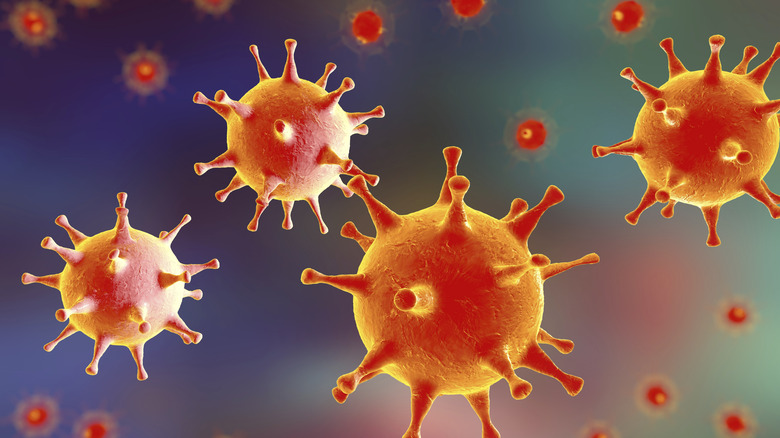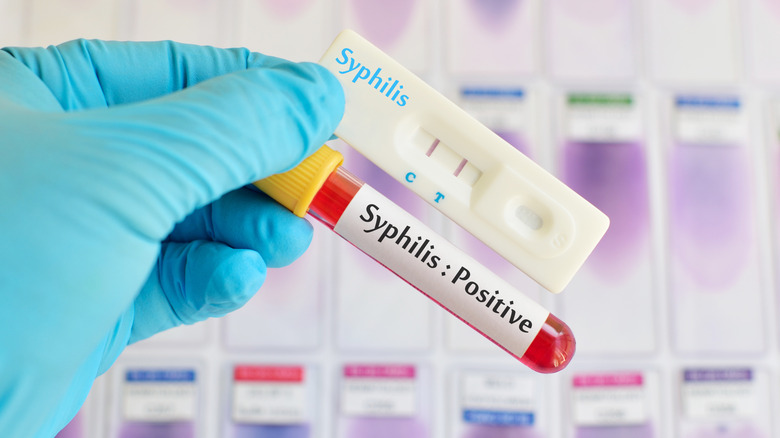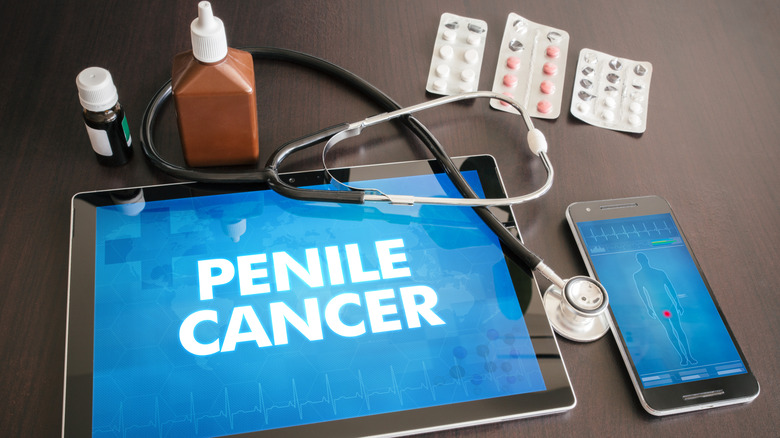9 Causes Of Penile Ulcers (And Symptoms To Look Out For)
Anybody can develop sores or lesions on or around their genital area, and given the natural sensitivity of the area's skin and the fact that bacteria can gain easy access to the exposed tissue, these sores can evolve into ulcers, which are often described as painful, slow-healing wounds. When it happens to people with penises, these uncomfortable lesions are called penile ulcers. Depending on their cause, penile ulcers can vary in size, depth, and severity. However, they typically start small, even as something as unnoticeable as a rash, and grow to become deeper wounds that may or may not leak pus.
The causes of penile ulcers can vary widely, ranging from infections like herpes simplex virus (HSV) and syphilis to non-infectious conditions such as lichen planus or penile cancer. In some cases, they might even signal an underlying medical condition. Nevertheless, the most common ones are the result of a sexually transmitted infection (STI). Thus, according to a 2020 article in American Family Physician, engaging in unprotected sexual activities, having numerous sex partners, and heavy alcohol or illicit drug use are common factors that might increase your risk of developing said ulcers. In any case, they all require medical attention, and identifying the cause is key to ensure proper treatment and avoid complications. This article explores nine common causes of penile ulcers, their associated symptoms, and whether there are any available treatment options.
Signs you might have a penile ulcer
A penile ulcer is typically characterized by a break in the skin or mucous membrane. The main sign you might be dealing with an ulcer down there is if you notice an open or blister-looking wound anywhere from the shaft to the head of your penis. However, note that genital ulcers might also develop on the scrotum or anus. In addition, penile ulcers are often accompanied by symptoms such as redness, swelling or tenderness, itchiness, burning, and pain or discomfort while peeing or during sexual activities.
Moreover, depending on the cause, some ulcers might produce a discharge that may range from white or clear to yellow-colored or resembling pus. Plus, some ulcers may also be associated with other systemic symptoms like fever or swollen lymph nodes, which could suggest an ongoing infection that must also be addressed. Keep in mind that, unlike a canker sore, genital ulcers don't resolve on their own. Therefore, visiting your healthcare provider becomes a must so they can help provide an accurate diagnosis and treatment options. The diagnosis process typically involves a physical exam and, in some cases, may also call for blood or urine tests or even a biopsy.
Herpes simplex virus
Herpes simplex virus (HSV) is the most common cause of STI-induced genital ulcers in the United States, which is primarily transmitted through sexual contact (per American Family Physician). Once contracted, HSV remains in the body for life, and developing ulcers (also known as having a herpes outbreak) will most likely be a recurring occurrence (via the Centers for Disease Control and Prevention (CDC)). Fortunately, the ulcers caused by HSV have distinct characteristics that make them easier to identify. Typically, people with a genital HSV infection develop ulcers that might start out looking like pimples or blisters. Yet, the National Library of Medicine (NLM) explains that they might quickly spread around, causing what began as a small lesion to fuse into larger ulcers. Luckily, these ulcers tend to be shallow, another distinctive HSV-ulcer trait that results in fewer residual scars.
First-time HSV-induced penile ulcers may last up to 20 days, and local symptoms such as pain, itching, inflamed lymph nodes, discharge, and painful urination might come alongside systemic symptoms like fever, headache, and muscle aches. In contrast, recurring outbreaks tend to be shorter in time, and symptoms remain local. According to the CDC, while there is no cure for HSV, several treatment options can help manage symptoms, reduce the frequency of outbreaks, and minimize the risk of transmission to others. Practicing safe sex by using condoms and limiting the number of sexual partners can significantly reduce the risk of contracting or spreading HSV.
Syphilis
Syphilis is an STI caused by the bacteria Treponema pallidum. When acquired sexually, syphilis can progress through multiple stages, each presenting with its own set of symptoms (via the NLM). According to the CDC, the hallmark of syphilis in its early stage (primary syphilis) is the development of an ulcer that forms at the site of infection, often on the penis in people who have them. These ulcers are typically round, with firm edges, and painless, which can lead to them being overlooked. Per the NLM, ulcers generally appear 10–90 days after exposure and may heal on their own within 10 weeks, even without treatment. However, healing does not mean the infection is gone. On the contrary, it progresses to secondary syphilis (the second stage), which can cause systemic symptoms like non-itchy rashes on your hands and feet, fever, fatigue, and patchy alopecia or hair loss. Once again, symptoms may resolve without treatment, meaning the infection will likely evolve to the final two stages, called latent and tertiary syphilis (via the CDC).
The latent stage is a period where symptoms seem to take a break. Yet, avoiding treatment can lead to tertiary syphilis, which can potentially cause severe complications, including damage to the heart, brain, and other organs up to 30 years after exposure. Fortunately, syphilis is treatable with antibiotics, especially in its early stages. Per the NLM, a single injection of penicillin is often sufficient for early stages, while tertiary syphilis may require multiple doses. Preventing syphilis involves practicing safe sex, including using condoms and being in monogamous relationships.
Chancroid
Chancroid is an STI caused by a type of bacteria called Haemophilus ducreyi. Though less common than other STIs in the U.S., it is a highly contagious condition that remains a significant cause of genital ulcers in certain parts of the world, particularly in areas like Africa or the Caribbean, and its infection can increase the risk of acquiring or transmitting HIV (via a 2017 paper in the International Journal of Dermatology). Penile chancroid ulcers can develop either on the shaft, foreskin, or glans, and soft, deep sores with ragged and reddened edges and a yellowish or pus-containing base are among its defining features. Besides the ulcers, up to 50% of people with this type of penile ulcer also develop painful and swollen nearby lymph nodes, which can appear either on one or both sides of the groin.
Chancroid treatment is straightforward and effective with an antibiotic prescription, which would not only kill the bacteria but promote healing and even help reduce the risk of scarring. However, getting a quick and precise diagnosis might be trickier, seeing that chancroid ulcers can be confused for HSV or syphilis ulcers. Thus, getting a chancroid diagnosis involves ruling out these two STIs first. Yet, once treated, the infection can be cured. Lastly, chancroid can also be prevented with consistent condom use and getting regular STI screenings, particularly for people with multiple sex partners.
Lymphogranuloma venereum
Lymphogranuloma venereum (LGV) is an STI caused by a specific strain of Chlamydia trachomatis, which is different from the strain that causes the other and more common STI with the same name. While it is relatively uncommon in the U.S., LGV outbreaks have been increasingly reported in North America, namely among men who have sex with men. According to the NLM, LGV primarily affects the lymphatic system (hence the "lympho" portion of its name), and it is characterized by a three-stage progression, each presenting with unique symptoms.
The first stage might begin as early as three days or as late as one month post-exposure, and it is characterized by small, painless ulcers that usually heal on their own within days, which is why people tend to overlook them, facilitating the STI's progression toward the second stage, where it spreads to the lymph nodes in the inguinal or groin area. This stage happens roughly two to six weeks after the primary stage, and it's characterized by painful, swollen lymph nodes that might form abscesses or drain pus. In addition, other systemic symptoms like fever, fatigue, and muscle aches tend to accompany this stage. Lastly, LGV can enter the third stage if left untreated, leading to symptoms like ruptured lymph nodes and complications like genital disfigurement or narrowing of the rectum.
Like other STIs, LGV can be prevented by practicing safe sex, and it is commonly treated with antibiotics, with a 21-day course of doxycycline being the standard treatment.
Granuloma inguinale
Granuloma inguinale is an STI, also known as donovanosis. It is caused by a bacteria called Klebsiella granulomatis, and it is a common infection in some tropical and subtropical countries, including parts of India and Australia, South Africa, New Guinea, Guyana, and Brazil (via Healthline). According to the NLM, 90% of granuloma inguinale cases happen in the genital area, with penile lesions appearing either on the glans, prepuce, frenulum, or coronal sulcus. Like other common STIs, this one develops in three progressive stages. During the first one, you might notice small and painless pimple-like bumps. However, they're known for spreading outward, slightly turning red in the process. They might also bleed easily. The second stage is when the actual ulcers begin to form. These tend to be shallow and smelly, yet they might spread throughout the surrounding area. Lastly, the third stage is characterized by deeper ulcers that can cause permanent tissue damage.
Treatment for granuloma inguinale involves a prolonged course of antibiotics, which should be completed to avoid a number of complications, including having the bacteria spread to your bone, joints, and liver, which would increase your risk of developing arthritis in multiple joints, osteomyelitis, enlarged genitals, and even penile or other genital cancers. The use of condoms or other barrier protection methods during sex, as well as limiting your number of sexual partners, can help prevent granuloma inguinale. Also, getting regular STI screenings can promote early detection, especially for people who travel to or live in areas where the infection is more common.
Penis cancer
Penile cancer is a rare form of cancer that develops in the tissues of the penis. There are numerous types of penile cancers, yet squamous cell carcinoma is the most frequent one (via Medical News Today). One of the hallmark signs of penile cancer is the presence of a persistent ulcer or wound on the penis that doesn't heal within a month of its appearance. However, it is often accompanied by other symptoms, including rashes, bleeding under the foreskin, changes in skin color, having trouble pulling back the foreskin, and a foul-smelling discharge. Penile cancer-lead ulcers are painless, and symptoms tend to occur on the shaft, the glans, or the foreskin, depending on whether or not the person is circumcised. You might also notice swollen lymph nodes in the groin area in the advanced stages of the cancer.
Treatment for penile cancer depends on the stage and severity of the disease. Early-stage cancers may be treated with topical therapies, laser surgery, or minor surgical procedures to remove the affected tissue. For more advanced cases, partial or total removal of a part or all of the penis may be necessary, along with radiation or chemotherapy to address cancer spread. Preventing penile cancer involves maintaining good genital hygiene, getting vaccinated against HPV, and avoiding risk factors such as smoking and excess weight. Moreover, undergoing routine medical check-ups and early evaluations can help detect the cancer in its earlier stages, ultimately improving its outcome.
Behcet's disease
Behcet's disease is a rare and chronic autoimmune condition that damages blood vessels in different parts of your body. Its main symptoms are canker sores or mouth ulcers. However, genital ulcers tend to happen in 75% of people with the disease (via Healthline). Per the American Behcet's Disease Association (ABDA), these ulcers look the same as an oral canker sore, but in the penis or scrotum, and since they can be either shallow or deep, they usually leave a scar. In addition, being a chronic condition,penile ulcers can be expected to develop anywhere from twice to four times a year. Besides the mouth and genital ulcers, Behcet's disease can manifest with a wide range of additional symptoms, including eye and kidney problems, brain-related complications, intestinal ulcers, and arthritis. Lastly, according to the NHS, unlike ulcers caused by STIs, the sores in Behcet's disease are not contagious and usually heal within one to three weeks.
Treatment for this condition focuses on managing symptoms and reducing inflammation. In some cases, over-the-counter anti-inflammatory drugs might be all you need to stop a flare-up, and ulcers are typically treated with topical corticosteroid creams. Additionally, immunosuppressive drugs might help keep your immune system from attacking your body. However, not everyone needs to go down this path (per Healthline). Although Behcet's disease is not preventable, leading a healthy lifestyle and practicing stress management techniques between flare-ups can help you control your triggers and reduce the active phases of the disease.
Diabetic ulcer
Diabetic ulcers, although more commonly associated with the feet, can also appear in other areas, including the genital region. This happens because, in people with diabetes (especially those with a poorly managed disease), wound healing tends to be a slower process thanks to a combination of factors caused by high blood sugar levels. These factors include reduced blood circulation, which reduces oxygen and nutrient delivery to tissues; nerve damage, which reduces sensation, making it hard to notice new wounds; and a weakened immune response, meaning that your body has to make an additional effort to fight off infections, all of which facilitate ulcer development.
A 2005 article in Clinical Diabetes chronicled the case of a 50-year-old patient who had developed an ulcer on the tip of his penis. The ulcer began as a blister that ruptured, leading to the formation of an open sore that was described as inflamed and painful, especially when peeing or having sex. After ruling out common STIs, doctors diagnosed the patient with type 2 diabetes, evidenced by high blood sugar levels, which explained why the ulcer had not healed in over 14 days. In addition, test results confirmed a yeast infection caused by the fungus Candida albicans, for which people with diabetes have an increased risk. Treating diabetic penile ulcers focuses on wound care and addressing underlying diabetes management. In this case, it required an antifungal cream. However, preventing diabetic ulcers involves maintaining good blood sugar control, practicing excellent hygiene, quitting smoking, and monitoring for early signs of skin damage.










